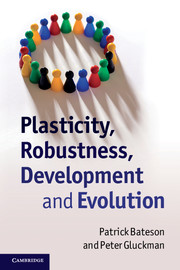Book contents
- Frontmatter
- Contents
- Preface
- Acknowledgements
- 1 Setting the scene
- 2 Clarifications
- 3 Developmental robustness
- 4 Plasticity
- 5 Integration of robustness and plasticity
- 6 Current function of integrated developmental processes
- 7 Evolution of developmental processes
- 8 Impact of developmental processes on evolution
- 9 Development and evolution intertwined
- References
- Index
5 - Integration of robustness and plasticity
Published online by Cambridge University Press: 05 August 2011
- Frontmatter
- Contents
- Preface
- Acknowledgements
- 1 Setting the scene
- 2 Clarifications
- 3 Developmental robustness
- 4 Plasticity
- 5 Integration of robustness and plasticity
- 6 Current function of integrated developmental processes
- 7 Evolution of developmental processes
- 8 Impact of developmental processes on evolution
- 9 Development and evolution intertwined
- References
- Index
Summary
Up to this point we have dealt separately with the phenomena that we have grouped under the general headings of robustness and plasticity. However, the central message of this book is that the developmental processes that give rise to an individual's phenotype are not polar opposites, nor are they independent of each other. Indeed, plasticity is often regulated by robust mechanisms and robustness is often generated by plastic mechanisms. In this chapter we describe some aspects of how these processes are integrated.
The chapter opens by clarifying concepts of how the organism interacts with its environment. It then moves on to an account of sensitive periods in development, in which experience can have a particular impact on the phenotypic characteristics of an organism. The environmental cues are often highly specific; in the behavioural literature the animal's preferences are generally referred to as predispositions. Learning is the archetype of plasticity. Yet learning processes are highly regulated by robust mechanisms. These are discussed and then the chapter turns to the immune system, the workings of which have sometimes been likened to learning. Here again they involve the integration of robust mechanisms and adaptive plasticity. Finally, the molecular mechanisms of epigenetics are discussed in some detail since they are central to understanding how developmental mechanisms are integrated. At the end we return to our critique of the hard and fast distinction sometimes made between robustness and plasticity.
- Type
- Chapter
- Information
- Plasticity, Robustness, Development and Evolution , pp. 46 - 62Publisher: Cambridge University PressPrint publication year: 2011
- 1
- Cited by



